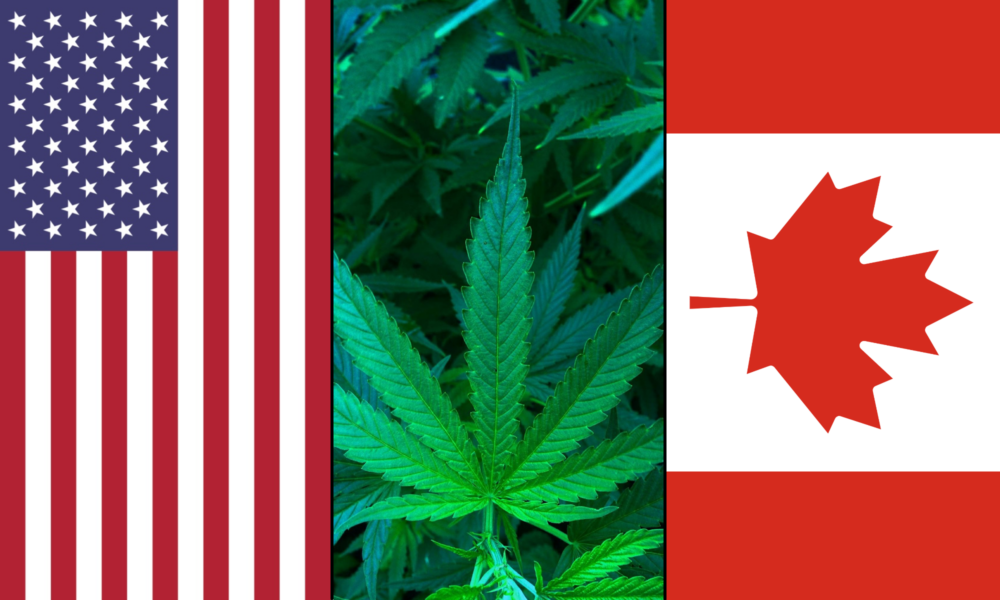A new survey published in the Journal of Cannabis Research found strong majority support for legal cannabis among respondents from both the United States and Canada, along with just under half of people in both countries saying that they consume cannabis. The trends were overall very similar between the two nations even as Canada has federal cannabis legalization and the U.S. does not.
The eight-page paper, “Comparison of perceptions in Canada and USA regarding cannabis and edibles,” examines data from surveys of 1,047 Canadian and 1,037 U.S. residents. “The analysis and findings evolved into 4 themes,” wrote the four-author research team: “acceptance and consumption, normalization, edibles, and education.”
The study found that usage rates between American and Canadian respondents were largely similar, with 45 percent of Canadians and 42 percent of Americans reporting they consume cannabis. Of those who currently consume, roughly 1 in 3 in the U.S. use marijuana daily, while about 1 in 4 Canadian consumers were daily users.
The report notes, however, that U.S. consumers “are less likely to purchase from legal sources than Canadians,” which they say is likely attributable to the fact that adult-use cannabis remains prohibited in most U.S. states, “and this may encourage a portion of recreational consumers to seek products from illicit sources.”
Attitudes toward marijuana legalization also were similar between respondents from the two countries, with 78 percent of Canadian respondents and 75 percent of Americans saying they agreed or strongly agreed with legalizing cannabis.
As for local regulation, a majority of Canadians (56 percent) said they either agreed or strongly agreed that municipal governments should not be able to ban retail cannabis within their boundaries, which authors noted “was an almost total reversal of sentiment prior to legalization.”
A minority of respondents in the U.S. opposed local authority to ban retail, meanwhile, with 44 percent saying they agreed or strongly agreed bans should not be allowed.
“Consumers in North America now perceive cannabis in a more normalized way,” the authors conclude. “Yet, one of the roadblocks to further success, aside from regulatory restriction, is the level of knowledge and understanding most people have about cannabis. As shown in this report, there is a substantial desire (and need) for cannabis consumers and the ‘canna-curious’ to learn more about the plant and how its phyto-chemicals may benefit their physical and mental health.”
The findings, they added, “challenge the notion that a country must legalize cannabis federally to change how it is broadly perceived socially,” given that Canada legalized marijuana nationwide in 2018, while the U.S. still puts cannabis in its most restricted class of substances.
The researchers also noted, however, that “Canadians’ responses show they are more relaxed than their American neighbors about publicly acknowledging cannabis consumption”—as well as more relaxed than they were when legalization began.
“Fewer Canadians express concern about others knowing they consume cannabis or care much if others partake than when cannabis was first legalized in October 2018,” the report says.
Cured cannabis flower was the most popular cannabis product used in both countries, with just under half of consumers in the U.S. (47.4 percent) and Canada (45.2 percent) saying they prefer that format. Edibles and beverages were the second most popular in both countries.
Consumable oils and tinctures were a close third in Canada, with 22 percent of consumers saying they preferred those formats, compared to 8.7 percent in the U.S. American consumers preferred concentrates for vaping, at 8.9 percent compared to 7.2 percent in the U.S. Dabbable concentrates, like hash and shatter, were the least popular of specified product types, at 1.8 percent in the U.S. and 1.4 percent in Canada.
The study found that a subset of consumers in both countries increased their marijuana use during the COVID-19 pandemic, with 14 percent of Canadian consumers and 16 percent of American consumers reporting upticks in use.
As part of the survey, which was administered in mid-2021, participants were also asked directly whether they planned to increase their use of marijuana edibles. “Respondents maintain that they intend to increase their usage, with edibles attracting a rising level of interest,” the report says. Specifically, 21 percent of American buyers said they planned to purchase more edibles, while 13 percent of Canadian respondents did.
Meanwhile just under 3 in 10 consumers in both countries said they do not use edibles.
Authors of the study come from a variety of institutions in Canada, including Dalhousie University in Halifax, Toronto-based SCS Consulting, Agri-Food Analytics Lab at Dalhousie University and the University of British Columbia.
Another recent study out of Canada found that the proportion of high school students who said marijuana was easy to access fell in recent years, during a period in which legal retail sales locations opened across the country.
A recent American study, meanwhile—conducted by the University of Michigan with funding from the National Institute on Drug Abuse—concluded that teen cannabis use was mostly unchanged following states’ legalization of the substance.
The report found that rates of past-year cannabis use “remained stable for all three grades surveyed,” remaining below pre-pandemic usage levels even as more state marijuana markets opened and expanded for adults.
The studies come amid a broad uptick in academic literature into marijuana, with a recent analysis from NORML concluding that researchers have published 32,000 scientific papers on marijuana over the past 10 years—including over 4,000 in 2023 alone.
Cannabis Holds Potential To Prevent And Reduce Severity Of COVID-19, While Treating Long-Term Symptoms, Study Finds
Read the full article here

